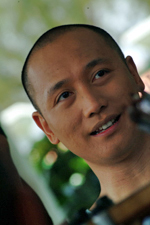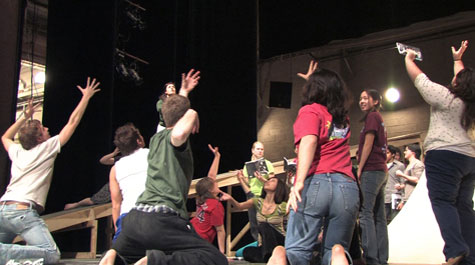'Purple' brings professor's story to W&M stage
That experience led the William & Mary professor to write the play "When the Purple Settles," in the hopes that it would help provide "a frank and candid answer to our children when they start wanting to know the truths about our family," he said.
"This is my life's story, plain and simple," said the newly tenured Director of Asian Studies and Associate Professor of Theatre, Speech, and Dance. "But I also think it is everyone's story because every family has a secret, a life-changing secret that takes a lifetime to heal, to settle."
The original "hip-hopera," which has achieved international recognition, is now set for its American premiere at William & Mary's Phi Beta Kappa Hall on Feb. 26 to 27 at 8 p.m., Feb. 28 at 2 and 8 p.m., and March 1 at 2 p.m. Tickets may be purchased at the William & Mary Box Office.
"Purple" is the first faculty-written play that has been produced at William and Mary since the early 1970s. It was developed at the Francis Ford Coppola New Play Festival at UCLA, and it has won several awards, including the 2002 Don Carlos Palanca Award in the Philippines.
Even with the international acclaim, Tanglao-Aguas said it is special to be able to share this piece with his family's community: William & Mary and Williamsburg.
"They get to know me, and I get to open myself up through the forum of theatre," he said.
Tanglao-Aguas was born in the Philippines, where he grew up seeing the effects of 450 years of foreign domination on his country's economy, military and politics. When he was 15 years old, he was detained and questioned for an essay he wrote on graft and corruption in his local government. Eventually, his family left the country because of the political and economic situation there. They went first to Nigeria and then on to California. Tanglao-Aguas said that in the 20 years from when the family first settled in America to it becoming an American family, "tectonically shocking changes happened in our family." When his sister gave birth to Hannah, it provided Tanglao-Aguas a chance to reflect on those changes, and in turn, that reflection gave birth to his play.
Because of the intensely personal nature of the project, the process was not just about writing. It was a chance for Tanglao-Aguas to "heal."
"Other families' scars are physical, others spiritual or psychological," he said. "In my case, I was born in a country teeming with all kinds of bruises and scars. What is fortuitous is that I have the ‘theatre' and the United States as places where I have the luxury of reflection and meditation to heal."
 If he had stayed in the Philippines, he probably still would have found a way to express himself, he said, "but I also would have been a very different person. I certainly would not have this opportunity to share my story with an audience who comes into it with a fresher perspective being so far from the Philippines."
If he had stayed in the Philippines, he probably still would have found a way to express himself, he said, "but I also would have been a very different person. I certainly would not have this opportunity to share my story with an audience who comes into it with a fresher perspective being so far from the Philippines."The play, which took 10 years to complete, centers on "Junior" who is a hip-hop artist/singer/dancer/writer who is about to become a father, said Tanglao-Aguas. As the play starts, Junior's wife is in the hospital ready to give birth, but Junior is not by her side. He is at home, writing a play about his mother, who was pregnant with her first child when Ferdinand Marcos was in power in the Philippines.
The play tries to illustrate why Junior chooses to write this play while his wife was giving birth, instead of being there with her, said Tanglao-Aguas.
"The implication of course is that Junior needs to write this play in order to become a decent father," he said. "For it is in the play where he must face the demons, secrets, skeletons in his family that un-reflected upon, might cause him to make some grave mistake in raising his family."
Though the themes of the play may seem heavy, Tanglao-Aguas emphasized that it is "actually quite funny."
"For indeed, if we were to go to the Philippines, the first thing you would notice is what a fun, laid back, even romantic and musical place it is," he said. "And why not? Poor people do not walk around moping all day - that's just not in the Filipino spirit. Instead, there is music and dancing everywhere."
Tanglao-Aguas calls his play a hip-hopera because "I would like to think the piece is very hip, very cool - ultra modern," he said. "But opera is also there in the music composed by Jerome Golden ('11), and while we will indeed have some opera singing, I also take opera to mean the truly elevated emotions and situations we only see in opera, be they lyric or soap opera."
Adding to the play's "cool" factor are its multi-media and interdisciplinary elements. Richmond-based artist Roberto Jamora worked with Tanglao-Aguas to create video installations projected during the play, in collaboration with Cameron Rust ('11), the production's projections designer.
Additionally, said Tanglao-Aguas, the play will include singing, dancing, poetry and even rollerblading. "Who knew that it was at William and Mary where I could find my collaborating choreographers like Prof. Leah Glenn, Kalyani Phansalkar ('11), Ravali Ceyyur ('11), and Jennifer Robinson ('11)."
"I guess I would not be so opposed to prefacing it as Cirque De Soleil with words dance, video and singing," he said.
Tanglao-Aguas said he hopes the audience members "have a blast."
"We're doing our best to make them laugh, cry, get angry, want to sing or dance," he said. "I hope people say, I never thought history could be that much fun and wild when put onstage. For sure, no one's seen a dance number in a scene where martial law is declared."

















